The Little Giant of Big Computing — an Overview of the IBM WorkPad z50 PDA
Introduction
Nowadays, few people will be surprised by a tablet or netbook. Smartbooks periodically appear - netbooks based on the RISC architecture (or rather ARM, in the overwhelming majority of cases).
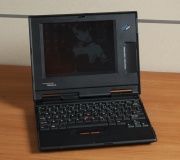
Compact devices with relatively large screens (7-11 inches), allowing you to comfortably work on the network or with a lot of documents. Their boom began in 2008, a few months after the announcement of the ASUS eeePC 701. Later, tablets began to gain popularity, smartbooks flashed on the horizon, which did not lose their popularity yet, but gave rise to tablets with a dock.
But as always, our new is a very well forgotten old. Today we will talk about what today would be called smartbook, but in those days this device was called differently. And in Russian it sounded and looked somewhat paradoxical - Keyboard Pocket Personal Computer (Keyboard PDA), which rather strangely combined with a kilogram weight and dimensions similar to an A5 sheet. No, of course there were really pocket keyboards, but today it's not about them. In English, the term for these devices was more correct - PDA with Keyboard is a personal digital assistant with a keyboard. That is why the name of the PDA was fixed in Russian, regardless of size.
So - our today's hero - IBM WorkPad z50. Big keyboard PDA in the days of his youth, smartbook today.
Acquaintance
At first glance, we have a compact laptop. The black case is made of very high quality scratch resistant plastic. Forms - strict, classic. At first glance, we have a ThinkPad. But this is not quite the case - the IBM WorkPad is on the nameplate. From 1998 to 2002, under this name, IBM produced Palm PDA clones, but among them was one original model, the one that we are considering today.
')
Shift the latch and open the computer. The similarity with the laptop does not disappear anywhere.
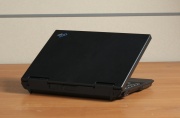
Keyboard, trackpoint - everything is just like ordinary ThinkPads. Only the number of indicators is less than usual - only 2 - battery status or notification indicator. Yes, instead of the keys F1-F12 - A1-A12.
And then we will be surprised at the relatively small for this size chassis screen - 8.2 inches, although the lid is designed for a 10.4 inch screen (Design is based on the popular ThinkPad 240 subnote. It’s based on a lot of changes.) On the side of which are the brightness and contrast buttons. This is not an error; the screen is made on a DSTN passive matrix. This is done not so much to reduce the cost as to increase the battery life. The screen has a resolution of VGA (640x480) and can display a color depth of 16 bits. The image quality is surprisingly decent for this type of matrix, but the contrast, brightness and viewing angles are certainly not as good as the screens on the active matrix.
And now look at the edges of the PDA laptop:

As always, there is nothing in front except the latch. Also, the back edge does not indulge with diversity - the battery lives there (like most modern laptops) and the external power supply socket (19 volts nominally), there is also a battery lock valve, combined with a hardware power switch. But the sides are more interesting in this regard. On the right is a proprietary COM-port connector, a slot for CF cards, an infrared port and a VGA connector. On the left - a modem connector, headphone and microphone jacks, a PCMCIA slot. The CF slot accepts cards up to 8GB, MicroDrive was originally recommended for it at 340MB (ultra-compact mechanical HDD the size of a CF card), in this instance there is a 4GB card. You can not only write data to it, but also install programs. PCMCIA slot can accept any 16-bit card for which there are drivers for Windows CE / MIPS. Unfortunately, the author’s network cards do not support this operating system.
In work
A full computer start takes about one to one and a half minutes. But, as a rule, PDAs do not turn off or restart for months. In sleep mode, the battery consumption is extremely small (a fraction of a percent per day), while in sleep mode the computer goes almost instantly.
Fast device can not be called. 131 Megahertz and the lack of L2 cache have a very strong effect. But working in the office suite is very comfortable, as in most programs created for such devices. Actually low performance is noticeable mainly when you start the application, but not at work. The system interface is not unusual, it is very similar to the classic design of Windows 95 / NT 4.0. What is striking is that the system (its interface) is designed for simultaneous work with one window - there is no possibility of changing the size of the windows - either on the whole screen or the fixed size of the form.
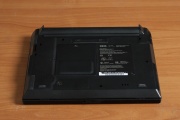
Complete with the system installed and application software. It includes Microsoft Office (Pocket versions of Word, Excel, PowerPoint, Outlook elements and even Access), Internet Explorer, Rapid Access utility (quick access to settings and device management), programs for working with a modem, a printer, a system archiving utility. .
Find the same third-party software for MIPS systems is already difficult, but still possible. The first was found Total Commander (the author of the program distributes versions for mobile devices for free), a convenient MP3 player is being searched.
If we talk about the physical sensations of working with the device - IBM did not let us down here. The keyboard is almost full-sized (95% of the standard), very pleasant to use. Trackpoint I will leave without comments - it is all the same ThinkPad track point. As a result, working on a table or other hard surface is very convenient. With work on weight is not so simple. In this regard, of course, touch devices and Toshiba Libretto 50CT also benefit, but it is nevertheless pleasant to hold the device in your hand, it is convenient to read, but it is somewhat more difficult to control the device than computers specially adapted for this purpose.
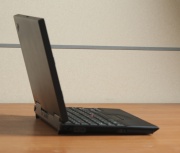
But do not forget that this device is more a laptop than a PDA. He has more opportunities for communication with the outside world, more opportunities for expansion, more autonomy from the "Big Brother". Yes, compared with classic subnotebooks, it has much lower performance, it is more difficult to find software. But it pays off with amazing battery life. With a standard battery weighing 1.2 kg, the computer can work up to 8 hours with an active screen (and its backlight), and the level of CPU usage has little effect on the running time. With an extended battery, the time increases up to 16 hours, with this, an adapter was supplied for using conventional AA batteries (“finger batteries”) - it is installed instead of the standard battery. And even at the age of almost 15 years, the battery is quite efficient. The author did not make accurate measurements, but for several hours she was exactly on the shoulder.
Conclusion
So we met with the "smartbook grandpa." It cannot be said that he was one of a kind - NEC, Sharp and others, mostly Japanese, manufacturers produced similar devices. But this particular device is the most notebook of all its kind. Moreover, the WorkPad was oriented not to the consumer, but to the professional market. But it would be a mistake to call this device class popular in those years. They were not so many released, few have survived to this day. They were bought by those who needed a tool for working with special properties. This model was released only 10 months - from April 1999 to February 2000, no replacement was released - the ThinkPad 240 with similar dimensions had a high productivity, it worked under the usual operating systems, but could not work on batteries for so long.
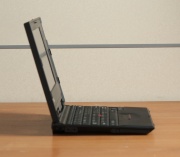
Nowadays it is difficult to find a WorkPad z50, especially in good condition, so this instance is a collectible rarity. It took several months for the author to look for a computer in excellent condition ...
PS Some additional information:
1) Link to the IBM WorkPad catalog - www.lenovo.com/psref/pdf/wwbook.pdf
2) Review from the past - 2005 (Eng.) - www.hpcfactor.com/reviews/hardware/ibm/workpad-z50
3) The page of the presented copy on the website of the private collection - www.digitalvintage.ru/IBM_WorkPad_z50
Source: https://habr.com/ru/post/194416/
All Articles